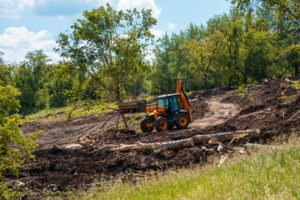Land Clearing Salado TX plays a vital role in preparing land for construction, agriculture, and other development projects. It involves the removal of trees, vegetation, rocks, and other obstructions to create a suitable and stable foundation for new projects.
This process requires careful planning and execution to ensure the land is cleared efficiently while minimizing environmental impact and preserving soil integrity. Land clearing is essential for making land accessible and usable, allowing for the development of residential, commercial, and industrial structures.
It also facilitates better land management by controlling the growth of invasive species and improving soil quality for agricultural purposes. The process of land clearing involves several stages, from assessing the site and determining the most effective clearing methods to executing the removal of vegetation and debris.
The first step in land clearing is a thorough site assessment. This involves evaluating the topography, soil composition, and existing vegetation to identify potential challenges and determine the best approach for clearing the land. Professionals conducting the assessment consider factors such as soil erosion risks, water drainage patterns, and the presence of protected plant or animal species. Understanding the natural features of the site allows for a more strategic and environmentally conscious clearing process. Planning the project carefully ensures that the cleared land will remain stable and suitable for its intended use.
Once the site has been assessed, the next step is to determine the appropriate clearing methods based on the type of vegetation and the condition of the soil. Manual clearing, which involves hand tools and small machinery, is often used for smaller areas or areas with delicate ecosystems. This method allows for more precise removal of vegetation and minimizes disturbance to the soil. Mechanical clearing, on the other hand, involves the use of heavy equipment such as bulldozers, excavators, and mulchers. This method is more efficient for larger areas but requires careful handling to avoid soil compaction and damage to the surrounding environment. Controlled burning is another method sometimes used to clear vegetation quickly, but it requires strict regulation and monitoring to prevent unintended environmental damage.
During the clearing process, careful attention is given to the removal of trees and large plants. Tree removal involves cutting down trees and either grinding down or removing the stumps. This prevents regrowth and ensures that the land remains clear for future development. Roots and underground obstructions are also addressed to create a smooth and stable surface. Vegetation and debris are either processed on-site through mulching or transported off-site for disposal. Mulching is an eco-friendly option that involves turning cleared vegetation into nutrient-rich material that can be used to improve soil quality. Removing debris efficiently prevents the buildup of organic matter that could interfere with future construction or agricultural work.
Soil preservation is a critical aspect of land clearing. Improper clearing methods can lead to soil erosion, loss of nutrients, and decreased land stability. To prevent these issues, professionals use techniques such as erosion control barriers, contour plowing, and reseeding with native grasses and plants. Retaining natural vegetation along the edges of cleared land helps stabilize the soil and prevent runoff. Proper soil management ensures that the land remains fertile and suitable for future use. The preservation of topsoil, which contains essential nutrients and organic matter, supports healthy plant growth and enhances the long-term viability of the cleared land.
Environmental impact is a significant consideration during land clearing. Removing vegetation disrupts local ecosystems and can affect wildlife habitats. To minimize these effects, land clearing projects often incorporate strategies to protect native species and restore natural habitats. Wildlife relocation, habitat preservation zones, and replanting efforts help maintain ecological balance and support biodiversity. Sustainable land clearing practices aim to balance development needs with environmental preservation, ensuring that natural resources are protected while meeting human demands for land use.
Land clearing is also essential for agricultural development. Clearing land for farming allows for the expansion of crop production and improved soil management. Removing trees and large plants creates open fields suitable for planting and irrigation. Proper soil preparation, including tilling and fertilization, enhances soil fertility and promotes healthy crop growth. Managing water drainage and soil erosion helps maintain stable growing conditions and increases agricultural productivity. The cleared land can be used for various types of farming, from row crops to orchards and livestock grazing.
Infrastructure development relies heavily on land clearing to create space for roads, buildings, and public facilities. Clearing land for infrastructure projects requires precise planning to ensure that the land can support heavy structures and traffic. Soil testing, grading, and compaction are performed to create a stable foundation. Proper drainage systems and erosion control measures are implemented to prevent flooding and land instability. Land clearing for infrastructure projects often involves collaboration between engineers, environmental specialists, and construction teams to ensure that the cleared land meets safety and structural requirements.
Commercial and residential development also benefits from land clearing. Creating space for homes, businesses, and recreational areas requires removing vegetation and preparing the soil for construction. Proper grading and leveling ensure that buildings are constructed on stable ground, reducing the risk of structural damage from shifting soil or water accumulation. Land clearing for residential and commercial projects also involves creating access roads, installing utilities, and managing landscaping to enhance the usability and aesthetic value of the property. Professional land clearing ensures that development projects proceed smoothly and meet regulatory and environmental standards.
Fire prevention is another important benefit of land clearing. Overgrown vegetation and dense tree cover increase the risk of wildfires, especially in dry or windy conditions. Clearing land to create firebreaks and reduce combustible material lowers the risk of fires spreading and causing extensive damage. Managed land clearing helps protect residential areas, infrastructure, and natural habitats from the devastating effects of wildfires. Removing dead trees, dry brush, and thick undergrowth creates a buffer zone that slows the spread of fires and provides access for emergency responders.
Maintaining the cleared land after the initial clearing process is essential for long-term stability and usability. Regular maintenance includes controlling weed growth, managing soil quality, and monitoring drainage systems. Replanting native vegetation and grasses helps prevent soil erosion and promotes healthy ecosystems. Monitoring the cleared land for signs of regrowth or environmental changes allows for timely intervention and preservation of the cleared area. Proper maintenance ensures that the land remains suitable for its intended use and supports sustainable land management practices.
Land clearing also supports environmental restoration projects by removing invasive species and restoring native plant and animal habitats. Controlled clearing of overgrown areas helps native plants thrive and improves biodiversity. Restoring wetlands, grasslands, and forest areas through strategic clearing and replanting enhances ecosystem health and provides habitat for wildlife. Land clearing as part of environmental restoration requires careful planning and execution to protect natural resources and promote ecological balance.
The economic impact of land clearing extends to various industries, including agriculture, construction, and infrastructure development. Preparing land for use increases property value, supports job creation, and stimulates local economies. Agricultural expansion improves food production and supply chain stability. Infrastructure projects enhance transportation, communication, and public services. Residential and commercial development creates housing and business opportunities, contributing to economic growth and community development. The efficiency and effectiveness of land clearing directly influence the success and sustainability of these economic activities.
Innovations in land clearing technology and techniques continue to improve efficiency and environmental sustainability. Modern equipment with advanced cutting and mulching capabilities allows for faster and more precise clearing. Eco-friendly methods, such as selective clearing and low-impact machinery, minimize environmental disruption and preserve soil health. Improved mapping and surveying technology enable more accurate planning and execution of clearing projects. The integration of environmental science and land management practices ensures that land clearing remains a responsible and effective solution for meeting development and agricultural needs.
Land clearing remains a fundamental aspect of land development, agriculture, and environmental management. The process involves a balance of technical expertise, environmental responsibility, and strategic planning. By understanding the natural characteristics of the land and using appropriate clearing methods, professionals can prepare land for various uses while preserving ecological integrity. The long-term success of land clearing projects depends on sustainable practices, proper maintenance, and a commitment to environmental stewardship. The benefits of land clearing extend beyond immediate development needs, contributing to economic growth, improved infrastructure, and enhanced environmental health.
